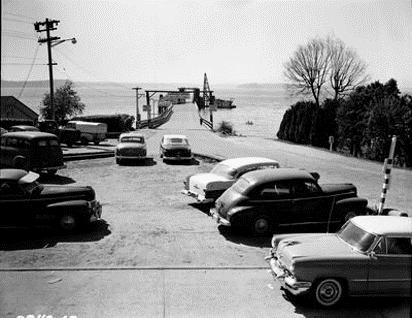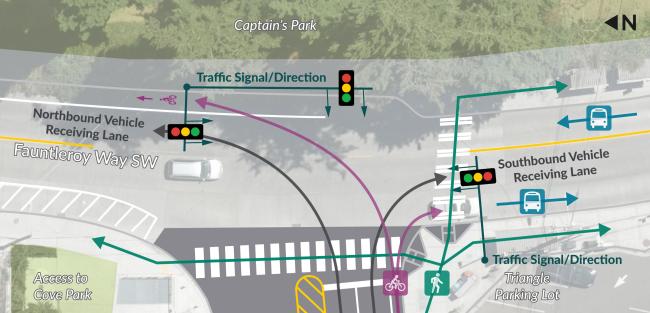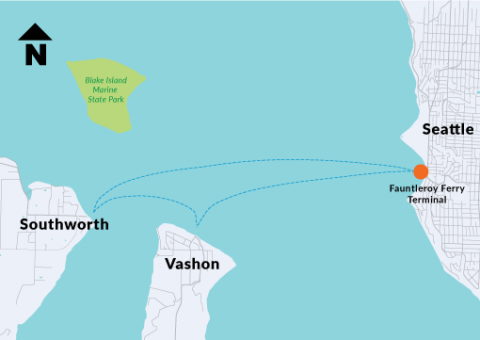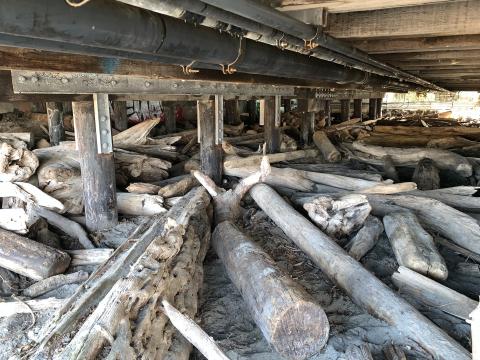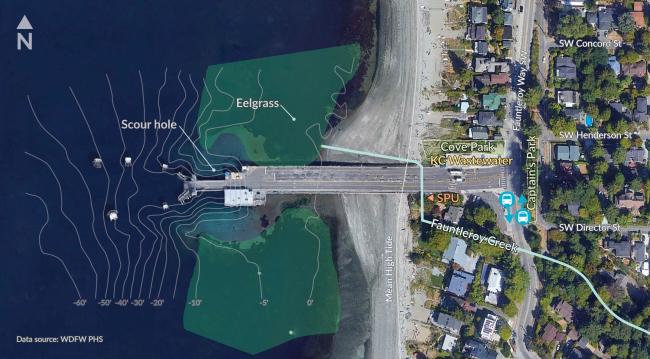During the Planning and Environmental Linkages (PEL) process, WSF evaluated a range of alternatives. We looked at dock concepts similar in size to the current dock (A Alternatives) and larger dock concepts that hold more vehicles (B and C Alternatives). We learned that bigger is not necessarily better for terminal operations, and we’re moving forward with a dock footprint based on the mid-size B Alternatives. This longer, narrow layout improves operational efficiency, holding between 124 and 155 vehicles on the dock, and minimizes impacts to nearby Cove Park. WSF will refine the design to minimize impacts to other environmentally sensitive areas.
WSF is hosting a virtual information session and an online open house to share more information about the screening process and the alternative moving forward. These two opportunities will feature the same information.
Online open house information:
Virtual information session:
- Watch the recording of the virtual information session from March 11.
- Fall 2016 - Launched a public process to gather community input on how to improve the “Triangle route”
- Fall 2017 - Near-term operational improvements at the dock
- Spring 2019 - Launched new sailing schedule for Triangle route
- 2019 - WSF releases 2040 Long Range Plan that recommends replacing Fauntleroy terminal
- Spring 2021 - Fauntleroy Terminal – Trestle & Transfer Span Replacement project starts
- Summer 2021 - Launched three advisory groups to advise WSF on options to replace the terminal
- 2021 to 2025 - Planning and Environmental Linkages study
- Fall 2025 – Begin construction of intersection improvements
- 2025 to 2027 - NEPA/SEPA environmental review
- 2027 to 2029 - Planned start of design and construction
Fauntleroy terminal was built in the 1950s and needs substantial preservation work. The terminal currently faces several challenges, including parts of the terminal are aging, seismically vulnerable and overdue for replacement. Rising sea levels could damage the superstructure from debris during high tides in the future. Long standing operational challenges include long lines caused by vehicles queuing on Fauntleroy Way and a small terminal with only enough dock space for approximately 80 cars and served by three 124-car Issaquah class ferries using a single slip.
Built in the 1950s, the terminal needs substantial preservation work.
This project relies on previous and future community engagement. The community engagement process includes three different advisory groups focused on the community, executive and technical aspects of the terminal. Input from advisory groups and the community will help shape the new terminal.
As WSF considers terminal replacement options, the project team will continue to engage its three advisory groups and the community.
Advisory groups
Washington State Ferries convened three advisory groups in summer 2021 to help shape the project during the planning phase. The advisory groups include representation from the three communities served by the “Triangle Route” (Fauntleroy, Southworth and Vashon Island) to encourage cross-community dialogue and the collaborative identification and development of project alternatives.
Community Advisory Group (CAG)
The CAG is comprised of people representing Ferry Advisory Committees (FAC), terminal neighbors, ferry customers, environmental and transportation organizations, and numerous other interests from the three communities served by the Fauntleroy/Vashon/Southworth route. The CAG provides feedback about project issues and concerns, community engagement efforts and potential alternatives. Following an open application process, we selected 24 members to serve on this advisory group.
Please email FauntleroyTermProj@wsdot.wa.gov if you would like to request recordings or materials from past CAG meetings.
- Ana White | Southworth resident
- Angus Macnab | King County resident/Vashon commuter student parent
- Anne Higuera |West Seattle business owner/Vashon resident
- David McDaniel | Fauntleroy and Vashon community member
- Devin Branson | Vashon resident and West Seattle commuter
- Emily Scott | Vashon Island Foodbank Executive Director
- Fletcher Sandbeck | Kitsap resident
- Frank Immel | Fauntleroy Community Association, FAC member, neighbor
- Gary English | Vashon community member
- Greg McKinnon | Manchester resident, daily ferry commuter
- Helen Westphal | King County resident
- Jon Wright | West Seattle Transportation Coalition
- Josh Gwynn | Southworth area community member
- Judy Pickens | Fauntleroy Watershed Council
- Justin Hirsch | Vashon Island FAC
- Malcolm Collie, Southworth FAC
- Mardi Clements | Fauntleroy Community Association, West Seattle resident near ferry
- Michelle McCormick | West Seattle and Vashon resident
- Richard Thorp | Southworth area community member
- Scott Harvey | Vashon resident, irregular ferry traveler
- Susan Frith | Vashon resident/former West Seattle resident
- Victoria Nelson | West Seattle Transportation Coalition Board Member, Fauntleroy resident
Technical Advisory Group (TAG)
Comprised of technical staff from municipal, county, state, and federal agencies, federal and state resource agencies, as well as local tribes. The purpose of the TAG is to provide technical input on existing conditions, the purpose and need for the project, alternatives development and screening criteria, and the overall practicability of potential concepts, solutions and/or mitigation concepts. The TAG will meet regularly throughout the planning phase.
Review the December 10 Technical Advisory Group meeting recording.
Currently the TAG includes participation from:
- Squaxin Tribe
- Stillaguamish Tribe
- Suquamish Tribe
- King County Metro
- King County Wastewater Treatment Division
- Kitsap Transit
- Kitsap County Public Works
- National Marine Fisheries Service
- Port of Seattle
- Seattle City Light
- Seattle Public Utilities
- Seattle Department of Transportation (SDOT)
- Seattle Parks & Recreation
- U.S. Army Corps of Engineers
- U.S. Fish and Wildlife Service
- Vashon Island Fire & Rescue
- Washington Department of Ecology
- Washington Department of Fish and Wildlife
- Washington State Department of Natural Resources
- Washington State Transportation Commission
Executive Advisory Group (EAG)
Comprised of local and state appointed or elected officials, transportation agency leadership, federal partners and tribal leadership. The EAG provides advice and input on how to prioritize needs, represent their constituents’ interests, and share feedback on key policy elements and project alternatives.
Recent EAG meeting
EAG members
- Leonard Forsman, Chairman of the Suquamish Tribe
- Sen. Emily Randall, 26th Legislative District
- Sen. Joe Nguyen, 34th Legislative District
- Rep. Joe Fitzgibbon, 34th Legislative District
- Rep. Emily Alvarado, 34th Legislative District
- Commissioner Charlotte Garrido, Kitsap County District 2
- John Clauson, Kitsap Transit Executive Director
- Ralph Rizzo, Federal Highway Administration Division Administrator
- Michelle Allison, King County Metro General Manager
- Steve Nevey WSDOT Assistant Secretary – Washington State Ferries
- Greg Spotts, Seattle Department of Transportation Director
- Councilmember Teresa Mosqueda, King County Council District 8 (invited)
- Councilmember Rob Saka, City of Seattle District 1 (invited)
View a full list of prior advisory group meeting recordings.
Community engagement about Level 3 alternatives
WSF hosted two public meetings and an online open house in May 2024 to provide an in-depth look at the Level 3 alternatives and screening criteria and an overview of upcoming project work.
Meeting Recordings
Watch this video to learn about the challenges the replacement project aims to address and the next steps towards construction.
Community engagement during Level 1 Screening
WSF hosted two community meetings and an online open house in May and June 2022 to share information on the project’s purpose and need, project alternatives and initial screening results. Review the engagement summary.
Share your questions and comments
Please share your questions or comments by emailing the project inbox at FauntleroyTermProj@wsdot.wa.gov. All advisory groups receive regular comment summaries of all comments received by the project inbox. Subscribe to project email updates here.
Intersection improvements at Fauntleroy Way SW
To support safe and efficient loading and unloading, WSF will improve the terminal intersection with Fauntleroy Way SW. This will make it easier and safer for people driving, walking, biking and rolling to get to and from the bus stops, terminal, and other destinations along Fauntleroy Way SW and beyond. WSF is working with Seattle Department of Transportation (SDOT) to add a signal to the intersection. The signal will be designed and operated to balance the needs of neighborhood traffic, buses and ferry traffic.
Because these safety improvements are a priority, WSF will complete this work in advance of the larger terminal replacement project. Crews completed early surveying work and traffic data collection near the intersection in Fall 2024. Crews also conducted geotechnical tests to study the soil and rock conditions under and near the roadway. WSF plans to begin construction of the intersection improvements in fall 2025 and complete construction by early 2026.
WSF will continue to work closely with partners such as King County Metro and the Community Advisory Group as the intersection and signal design progresses.
Good to Go! and Wave2Go Advance Ticketing Payment Options Study
Read a summary of Washington State Ferries’ Fauntleroy Ferry Terminal study on Good to Go! and Wave2Go use at the terminal.
2016 - 2018 Triangle Improvement Task Force Process
In Fall 2016, WSF launched a public process to gather community input on how to improve the "Triangle" route. As part of this process, WSF convened a citizen advisory group called the Triangle Improvement Task Force, an advisory group comprised of volunteers from each community served by the route. In its first year, the Triangle Improvement Task Force focused on short-term operational changes to the Fauntleroy terminal.
In 2018, the task force focused on providing feedback on three of WSF's long-term projects:
This project is located at the Fauntleroy Ferry Terminal in Seattle on the Fauntleroy/Vashon/Southworth "Triangle" route.
Based on results of Level 2 screening, WSF is developing a range of alternatives for two main options for replacing the terminal. Both options hold the same number of vehicles in a combination of on-dock holding and queuing along the shoulder of Fauntleroy Way SW.
Replace existing terminal – WSF replaces the terminal at the same location and similar size as the existing facility. The terminal would hold about the same number of cars on the dock as it does today, and remaining vehicles would queue along Fauntleroy Way SW while waiting for the ferry. WSF will consider strategies to improve terminal operations including Good To Go! and advance ticketing policies, and other operational changes like intersection improvements and features to make it easier to walk, bike and roll onto the ferry.
Expand terminal – WSF replaces the existing terminal and expands the dock to hold additional vehicles on the dock instead of along Fauntleroy Way SW. WSF needs to avoid or minimize permanent impacts to near-shore habitat and recreational areas, including Cove Park. WSF is no longer considering widening the dock (as shown in Level 1) to accommodate 186 vehicles. This alternative would avoid or minimize permanent environmental impacts while providing on-dock holding for 124 to 186 vehicles.
Since completing Level 2 screening, WSF has refined these two main options into a set of six detailed alternatives for further evaluation and screening.
All dock alternatives follow WSF’s Terminal Design Manual and include these elements:
- Replacing the dock at the same location as the existing facility.
- Accommodate 186 vehicles (one-and-a-half times the capacity of the Issaquah class ferries that serve the Fauntleroy/Vashon/Southworth route) in a combination of on-dock and Fauntleroy Way SW shoulder holding.
- Meeting current seismic design standards to make sure the new terminal can withstand a major earthquake and raising the dock to accommodate rising sea level.
- Space for a semitrailer truck to safely navigate through the terminal using designated holding lanes.
- Wider and safer lanes for vehicles and dedicated lanes for people walking, rolling, biking and driving motorcycles onto the ferry.
- Space for terminal operations, including storing materials, mechanical and electrical equipment, trash and recycling containers and parking for terminal supervisors.
- A new terminal building.
- At least two dedicated parking spaces to drop-off and pick-up passengers with disabilities.
- A larger toll plaza with two toll booths, a traffic attendant booth and staff restrooms.
- Minimal dock widening near the shoreline to minimize impacts to Cove Park and environmentally sensitive areas.
See the Level 3 Alternatives Summary for detailed descriptions of each alternative.
WSF is conducting a Planning and Environmental Linkages (PEL) study in partnership with the Federal Highway Administration per federal requirements (23 U.S.C 168 and 23 U.S.C. 139). The PEL study helps identify transportation issues, environmental concerns, community values and economic goals early in project planning. A detailed environmental review process will follow a PEL study, as required by both the National Environmental Policy Act and the State Environmental Policy Act. Information gathered in the PEL study is carried forward into the environmental review process, saving time and money.
Rising sea levels impact the future of the Fauntleroy Ferry Terminal.
One of biggest challenges facing the Fauntleroy Ferry Terminal is sea level rise. This project will include an extensive environmental review process and plan for future impacts to the terminal due to climate change.
In developing and evaluating terminal alternatives, WSF must consider important environmental resources and features near in the vicinity of the terminal, including:
- Intertidal and nearshore habitats, including eelgrass and macroalgae near the dock (shown in green above), provide valuable habitat for salmon and other marine wildlife.
- A scour hole where the vessel accelerating and decelerating has eroded the seabed and created a raised berm around the end of the trestle, preventing macroalgae growth.
- Fauntleroy Creek, which provides spawning habitat for coho salmon and coastal cutthroat trout.
- The aging dock is supported by about 430 creosote-treated timber piles and contains more than 1,000 tons of toxic creosote-treated timber—a known water pollutant.
- Cove Park and Captain’s Park offer public waterfront and green space access near the dock.


